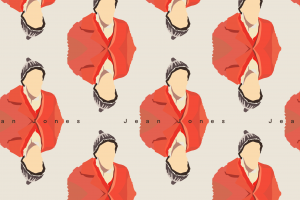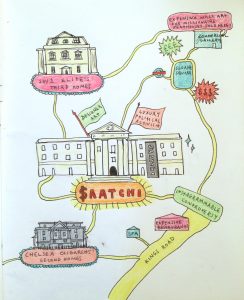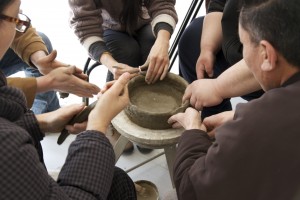
‘A World Away’ – Two Generations: Gabriella and Julian Bailey
by Anna Mayer | November 2, 2023

Julian Bailey’s painting ‘Four Youths on a Wall, Santa Maria del Mar’ is paradigmatic of his concise, colourful style, combining a figurative, observational method with abstraction. Donated to the Pembroke JCR Art Collection in 2007, ‘Four Youths’ will be displayed at the Pembroke JCR Art Gallery as part of Julian and his daughter Gabriella’s upcoming exhibition, entitled ‘A World Away’. Curated by fellow Oxonian Myroslava Hartmond, it is Gabriella’s debut exhibition, for which she has created an entirely new body of work. Asserting herself as an artist in her own right, it’s a testament to her fantastical, almost revelatory creative vision. ‘A World Away’ is an enchanting exploration of both the correspondence and divergence between her and her father’s respective artistic practices.
Both Julian and Gabriella draw nourishment from places that are rich with stories. Describing the Dorset countryside where she spent her childhood and youth, Gabriella invokes “rolling hills, and vast, expansive skies”. Her early years were pastoral and picturesque, surrounded by land, sea, and rugged terrain, growing up in the Old Vicarage and raised by artist parents. From a young age, creating was a sanctuary for Gabriella. “It all started with the line”, she tells me. “Drawing comes first – it’s primary”. Recourse to the simplicity of sketching is still central to her artistic practice today, observing the world around her through the sketchbook she carries with her at all times. Emphasising the importance of “the direct immediacy of the unmediated line”, she has always found a certain courage and confidence in committing to the permanency of her drawings, never wavering and never erasing.
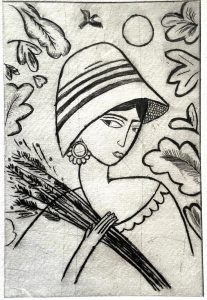
Her years as a student at Oxford, reading English Literature, were also deeply influential for Gabriella’s artistic development. Speaking of Hardy’s Jude the Obscure, Gabriella describes Christminster, representing Oxford, as “this glowing, radiant empire, far-off above the hills”. For her, Jude’s journey from Dorset to Oxford is not just poignant, but also quite personal. The imagery of Jude being confronted by the colossal city walls, outside of the cloisters and the quads, is, for Gabriella, timeless, abiding – “for some the city can still feel impenetrable, even despite the lack of city walls”. She tells me she aspires to create something that cuts through this impenetrability.
Graduating from New College with a first in 2021, she describes her decision to put down her pen and pick up her paintbrush upon completing her degree as “not a decision, but a necessity”. She speaks of the stories, histories, and manuscripts of the medieval era she studied as a separate world – self-contained, set apart. In creating what Myro calls her “medievalist mood”, she is mediating, conjuring, drawing stories across the chasm and into our own world where they can become tangible.
The mode of thinking from which ‘A World Away’ emerged seems, to me, one of binaries, of polarities. There is a distinctive dualism not only between the places of Oxford and Dorset, but between the material and the immaterial, the visible and the invisible. There is something sacred, something sacramental about the world that Gabriella and Julian depict. “All the figures in the paintings [and the prints] are beholden to this higher force,” Gabriella tells me. They exist “in relation to one another, of course, but also to something higher.” The titular dualism of ‘A World Away’ is the relationship between this remote, far-off realm and its fixity in the present, in the profane.
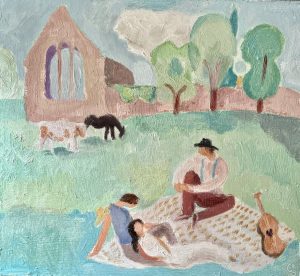
Gabriella and Myro are adamant, however, that ‘A World Away’ is not escapism. “It’s not about being invited to escape into their world,” Myro tells me, “it’s about them bringing that imagination, and colour, and story, into our own world, and, in the process, enriching it.” There is no doubt that Julian and Gabriella have a foot firmly in the here and now. Showing me her painting of Port Meadow, ‘The Ruin’, Gabriella carefully points out Godstow Abbey, the horses, the familiar cluster of trees in the middle distance. She works in dialogue with the world around us, as we know it. ‘The Ruin’ is an imagined scene, with an almost transcendent mystery, but it is illustrated and embellished by means of figures, places, and motifs that have a fundamentally quotidian beauty. Even the arsenal of characters from the collective imagination that the Baileys depict, drawing from a host of rich historical and literary influences, is given a physicality, an immediacy. Gabriella describes Tess of the d’Urbervilles as “a tragic, emblematic figure”, that, through Julian’s work, is pulled out of her lengthy literary legacy and is “made flesh and blood”. “They are not historical pictures, they are not period pieces”, Myro clarifies, “Julian paints Tess as if she were alive in Dorset today.” Gabriella calls it “the echoes of history in the here and now”.
It seems clear to me that, in ‘A World Away’, Julian and Gabriella are not sharing individual images, figures or scenes. Rather, as the title alludes to, they are offering up their worldview. For Gabriella, each painting and print, is a window, a viewpoint onto the otherworldly landscape from which she draws. This is a landscape that, for all my best attempts, can’t really be described. Gabriella, despite her eloquence and poeticism, always tries not to overexplain: “if it says too much, it says too little, paradoxically”. Thus, though influenced tangibly by the places of Oxford and Dorset and their literary, devotional, and artistic inheritances, what the Baileys are expressing is ineffable, inexplicable.∎
‘A World Away’ | Two Generations: Gabriella Bailey and Julian Bailey is on view 4th-19th November 2023 (11am-4pm on Saturday and Sunday only and by appointment) at the Pembroke College JCR Art Fund Gallery. Entry is free.
Words by Anna Mayer. Photography courtesy of the Pembroke College JCR Art Fund Gallery.

